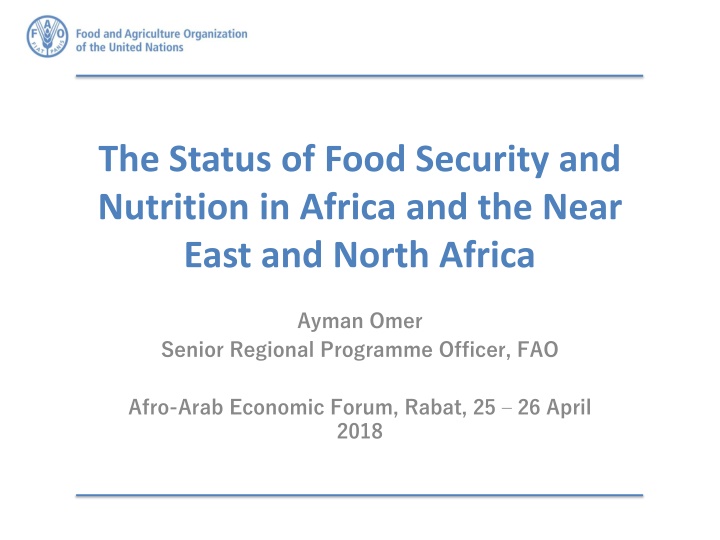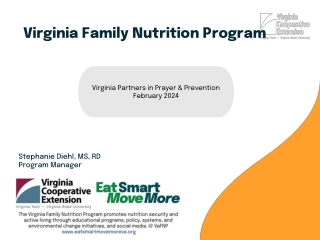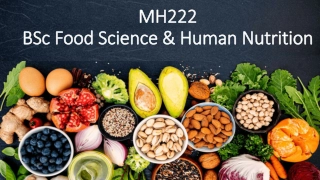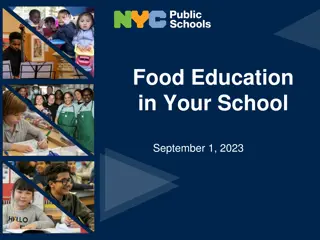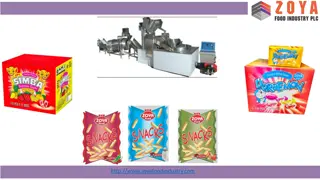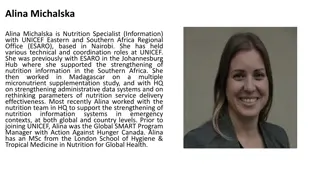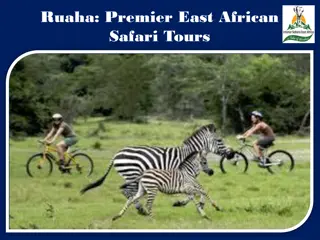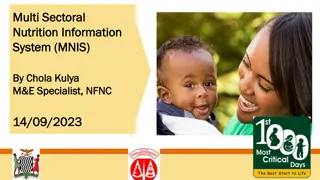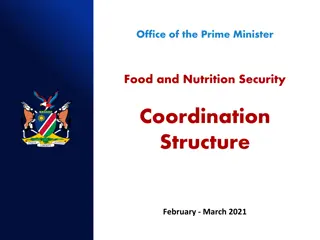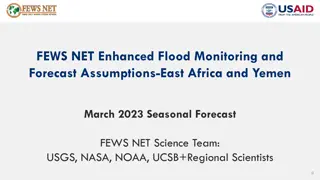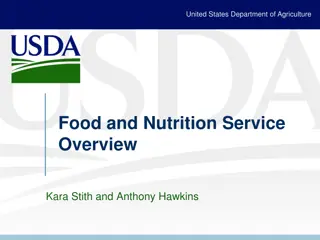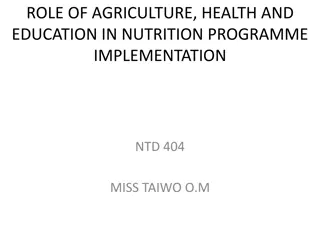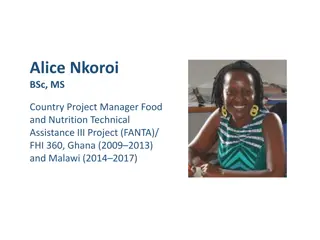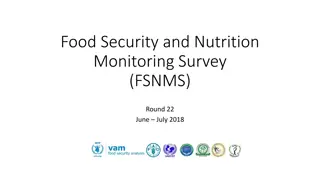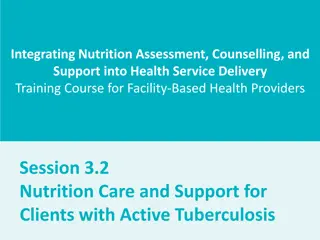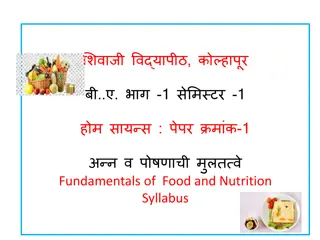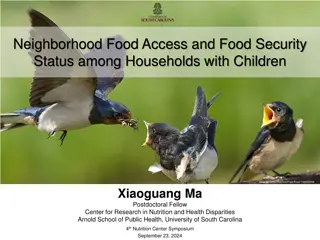Status of Food Security and Nutrition in Africa and the Near East
The presentation discusses the current state of food security, nutrition, and related challenges in Africa and the Near East region based on data presented at the Afro-Arab Economic Forum in Morocco. It highlights global hunger trends, child malnutrition statistics, rising obesity rates, and factors affecting progress in addressing food security issues such as conflicts, climate change, and economic slowdowns.
Download Presentation

Please find below an Image/Link to download the presentation.
The content on the website is provided AS IS for your information and personal use only. It may not be sold, licensed, or shared on other websites without obtaining consent from the author.If you encounter any issues during the download, it is possible that the publisher has removed the file from their server.
You are allowed to download the files provided on this website for personal or commercial use, subject to the condition that they are used lawfully. All files are the property of their respective owners.
The content on the website is provided AS IS for your information and personal use only. It may not be sold, licensed, or shared on other websites without obtaining consent from the author.
E N D
Presentation Transcript
The Status of Food Security and Nutrition in Africa and the Near East and North Africa Ayman Omer Senior Regional Programme Officer, FAO Afro-Arab Economic Forum, Rabat, 25 26 April 2018
Content Section 1: global overview Section 2: regional overview Section 3: what needs to be done? 25-26 April 2018 Afro-Arab Economic Forum - Morocco 2
Section 1 Global Overview 25 March 2018 3 Afro-Arab Economic Forum - Morocco
After a prolonged decline, world hunger is on the rise 1 in 9 people are hungry or 815 million people Source: FAO, SOFI 2017 Afro-Arab Economic Forum - Morocco 4
Chronic child malnutrition (stunting) continues to fall Still, 1 in 4 children or 155 million children are stunted Number of children under 5 that are stunted (millions) G L O B A L R E G I O N A L Source: UNICEF-WHO-The World Bank: Joint child malnutrition estimates 2017 Afro-Arab Economic Forum - Morocco 5
Obesity among adults is increasing in all regions 41 million children > 5 yrs of age were overweight in 2014 25-26 April 2018 Afro-Arab Economic Forum - Morocco 6
Drivers of Slowed Progress 1. Conflict 60% of hungry people live in countries affected by conflicts 2. Climate change and extreme weather events . 204 million people affected by disasters in 2016 (double the number in 015) 3. Economic slowdowns (before 2017) reduced investments on social protection, infrastructure and trade. 25-26 April 2018 Afro-Arab Economic Forum - Morocco 7
Section 2 Overview on Africa and the Arab Regions 25-26 April 2018 Afro-Arab Economic Forum - Morocco 8
Prevalence of Undernourishment Hunger 35 Prevalence of undernourishment (%) 28.2 30 25 28.2 21.3 20.1 20.2 20.4 20 15 10.0 9.7 8.8 8.4 8.3 10 5 0 Sub-Saharan Africa All NENA NENA Conflict 25-26 April 2018 Afro-Arab Economic Forum - Morocco 9
Food Insecurity Experience Scale (FIES) Nutrition Africa NENA World Average Severe FI 31.0% 9.5% 7.4% Moderate FI n/a 31.4% 19.9% Prevalence of moderate and severe Food Insecurity 2014-2015 Asia Latin America Africa NENA region Developing regions Developed regions World 0 10 20 30 40 50 60 Afro-Arab Economic Forum - Morocco 10
Child Malnutrition Indicators (2016) Source: UNICEF, WHO & World Bank, Joint child malnutrition estimates 2017 & * FAO Regional Overview on Food Security and Nutrition 2017 25-26 April 2018 Afro-Arab Economic Forum - Morocco 11
Drivers and Risk Multipliers - Fragility Climate change and extreme weather events Conflict Water scarcity Low economic growth Low agricultural productivity Low inter-regional agriculture trade High dependence on food imports High population growth 25-26 April 2018 Afro-Arab Economic Forum - Morocco 12
1. Climate change and extreme weather events NENA 45% of agriculture areas are exposed to the impact of climate change 90% of the total land lies in arid and semi- arid areas All farming systems especially the rain-fed system, will be exposed to increased aridity and to declines in water availability SSA 2016 s El Ni o caused 12% drop in cereal production compared to 2015 La Nina and climate change contributed to the famine situation in South Sudan, Northeast Nigeria and Somalia Afro-Arab Economic Forum - Morocco 13
2. Conflict Over 2/3 of the conflicts in the world are in NENA and SSA NENA - is the home to the highest number of conflicts in the world (32% NENA countries in conflict in 2015 compared to 15% for the rest of the world) - the least peaceful region in the world - bears the highest cost of conflict worldwide (21% to 67% of GDP) - contributes only from 5 countries, 76% of the forcibly displaced population in the world (50 million people out of the 65.6 million people in 2016) Afro-Arab Economic Forum - Morocco 14
3. Water scarcity SSA NENA Per capita fresh water <10% of the world average Water resources decreased by 2/3 in the last 40 years and; are expected to fall over 50% by 2050 Water scarcity affects 1 in 3 people Arid land expected to grow by 5- 8% by 2080 Drought Horn of Africa (2011) and the Sahel (2012) Afro-Arab Economic Forum - Morocco 15
4. Low economic growth NENA Fiscal growth slowed down to 2.7% in 2016 and further down to 2.1 in 2017 (WB) SS. Africa Significant variations among countries but positive growth on average since 2000. Average per capita income is 5% of the one of USA 25-26 April 2018 Afro-Arab Economic Forum - Morocco 16
5. Low agricultural productivity Cereal productivity (1961 2013) 6000 5000 kg per hecrates 4000 3000 2000 1000 0 East Asia & Pacific (all income levels) Latin America & Caribbean (all income levels) Near East & North Africa (all income levels) Sub-Saharan Africa (all income levels) World 25-26 April 2018 Afro-Arab Economic Forum - Morocco 17
6. Low inter-regional agriculture trade NENA and SSA have the lowest levels of intra-regional agricultural trade after CIS 1000 2013 2014 900 800 700 Billions of US dollars 600 500 400 300 200 100 0 intra-EU agricultural trade intra-ASP agricultural trade intra-LAC agricultural trade intra-NENA agricultural trade intra-African agricultural trade intra-CIS trade, agricultural trade Afro-Arab Economic Forum - Morocco 18
7. High dependence on food imports NENA is the largest food importer in the world (> 30% of world imports) Around a third of all calories consumed in Africa are imported SSA: Value of food imports (2000 2014) NENA: cereals production & consumption (1996-2014) Afro-Arab Economic Forum - Morocco 19
8. High population growth and other demographic factors Population growth rates have dropped in many countries, but still above the global average (NENA = 2%; SSA = 2.8% and world average = 1.1%) By 2100, Asia and Africa are expected be home to 9 billion, out of the projected 11 billion people globally Rural - urban migration increasing urbanization Gender inequality 25-26 April 2018 Afro-Arab Economic Forum - Morocco 20
Section 3 What needs to be done? 25-26 April 2018 Afro-Arab Economic Forum - Morocco 21
Join forces to achieve SDGs by 2030 2.1 end hunger & ensure access by all people to safe, nutritious & sufficient food 2.1 end all forms of malnutrition Achieving Zero Hunger by 2030 (SDG2) requires an esti- mated additional $267 billion / year ($181 billion for rural areas). 25-26 April 2018 Afro-Arab Economic Forum - Morocco 22
Ensure appropriate policies Some key questions .. just examples Should we continue subsidizing cereals in water-constraint s regions? Crop economic water-productivity in the Arab Region, 2014 1.4 1.2 1 USD/m3 0.8 0.6 0.4 0.2 0 Wheat Barley Maize Rice, paddy Average Cereals Dates Oranges Grapes Apples Watermelon Average Fruits Do we have the right water policies? How much we invest in social protection and other pro-poor policies? Do we apply nutrition-sensitive policies? Do we have the right mechanisms to address the root causes of conflicts? How we promote inter-regional and regional integrations? 25-26 April 2018 Afro-Arab Economic Forum - Morocco 23
Invest in agriculture but also ensure quality More investment in agriculture would enable 70% of Africa s youth to meaningful jobs in the sector NEPAD By 2016, only 5 of the 54 AU states (Zimbabwe, Malawi, Madagascar, Ethiopia and Burkina Faso) are implementing Maputo Declaration / Malabo Declaration (10% of national budgets to agriculture) . In NENA, average spending on agriculture is less than 2% of national budgets. Experience from some SSA s countries suggest that quality of investment in agriculture is as important as the volume. 25-26 April 2018 Afro-Arab Economic Forum - Morocco 24
Enable agriculture transformation Holistic value chain and territorial approaches Promote agribusinesses Invest in rural infrastructures Involve private sector Empower institutions Etc. 25-26 April 2018 Afro-Arab Economic Forum - Morocco 25
Sustain peace and ensure holistic resilience-building approach in conflict and protracted crises contexts Work towards achieving SDG16: Peace and Justice Apply a holistic resilience building approach that includes: - Conflict-sensitive analysis and programming, - Integrated humanitarian, development and peace-related interventions - Multi-sectoral investments (agriculture, food, water and sanitation, and education) - Support to governance and peacebuilding Out of protracted crisis contexts, only Ethiopia reached the MDG target of halving the number of undernourished people 25-26 April 2018 Afro-Arab Economic Forum - Morocco 26
Manage natural resources sustainably Disasters cost $147 billion in 2016 (compared to US$90 billion in 2015) 25-26 April 2018 Afro-Arab Economic Forum - Morocco 27
Thank you Contact us Ayman.Omer@fao.org Florence.Rolle@fao.org
